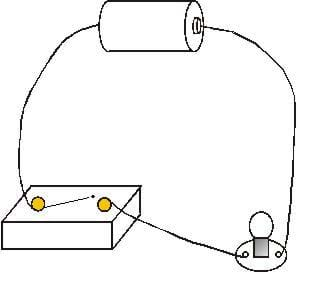In today's lesson, I am going to teach you how does light come from. In general physics terms, lights are electromagnetic radiation of a wavelength that is visible to human eye. Many of you will surely know that the light inventor was Albert Einstein, the genius guy who have make our lives easier at night, but studying light for me is very hard just because of many types of laws that we need to follow, not just E = MC^2. Quite pathethic for me by just following isn't? I wonder how to disobey their laws and create my own law.
Enough crap! Let's start our lesson immediately. Our first lesson is this following simple circuit:
A simple circuit consist of a battery and a lamp. How does the bulb lights up? The battery itself has one or more electrochemical cells that convert stored chemical energy into electrical energy. Then the electrical energy converted is then transferred to the bulb by wire conductors. Normally we use one wire connecting the positive battery side and one side of the bulb holder, and another wire connecting the negative battery side and another side of the bulb holder. Then voila! The bulb lightens up! It's pretty simple to understand actually.
At home, you always turn on the switch to light up the lamp. Similar to the circuit shown below, you just only need to add a switch to be either turn on or off the lights.
Go try it cuz this is fun to play. And remember, whatever you study light in physics and in engineering are totally different. Becoming an electrical engineer will not be that easy, but that's just for me. *sobs*



No comments:
Post a Comment